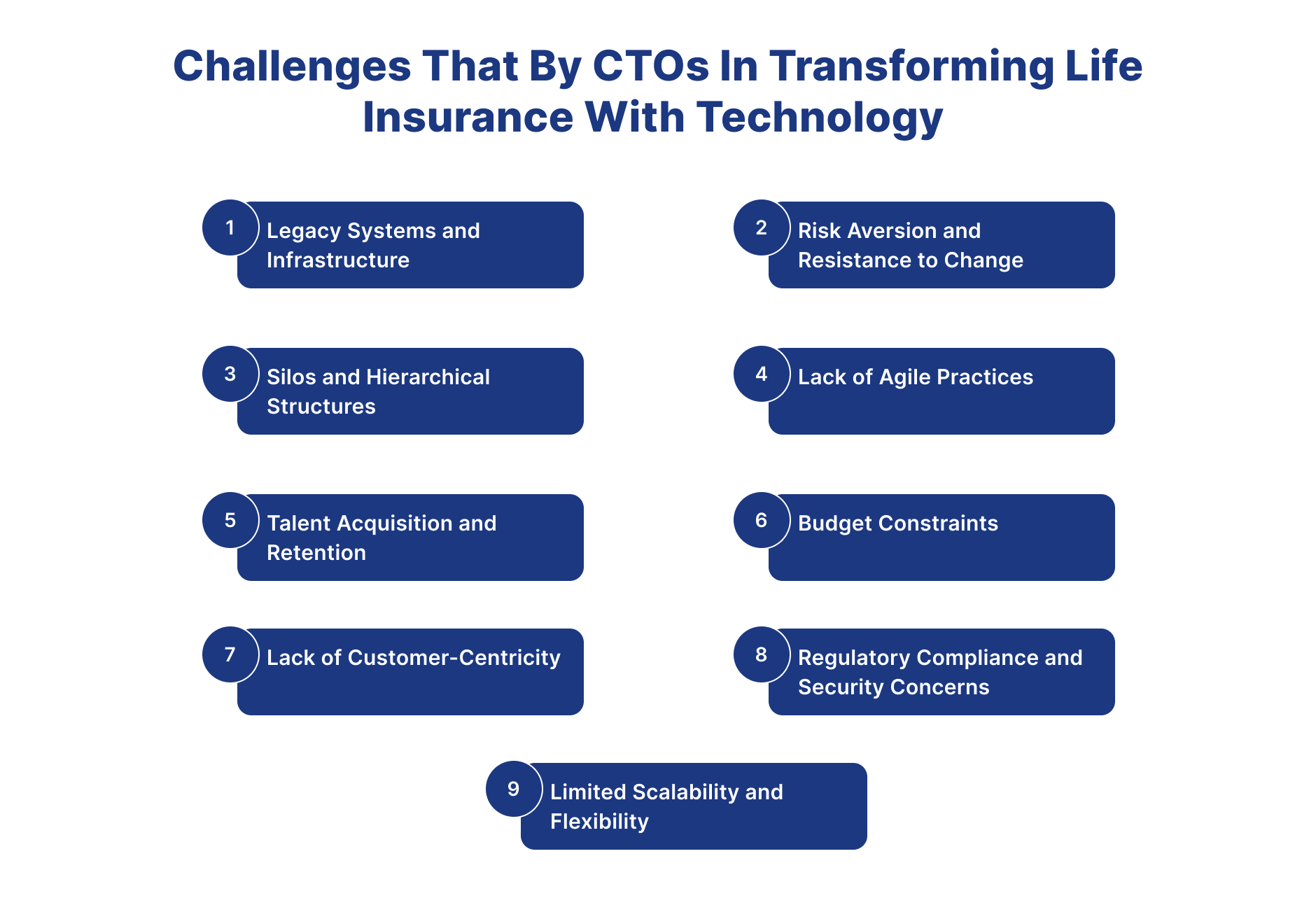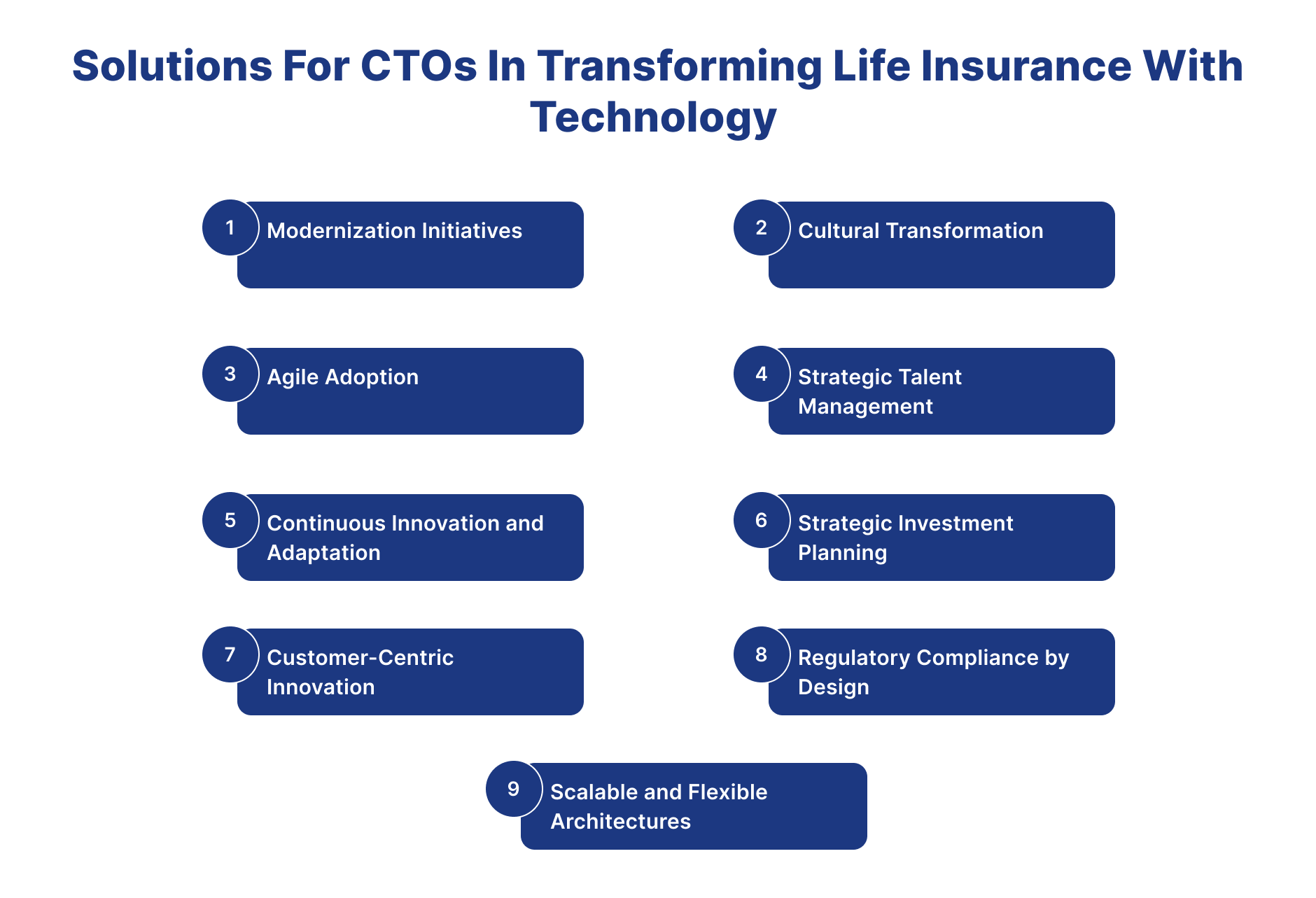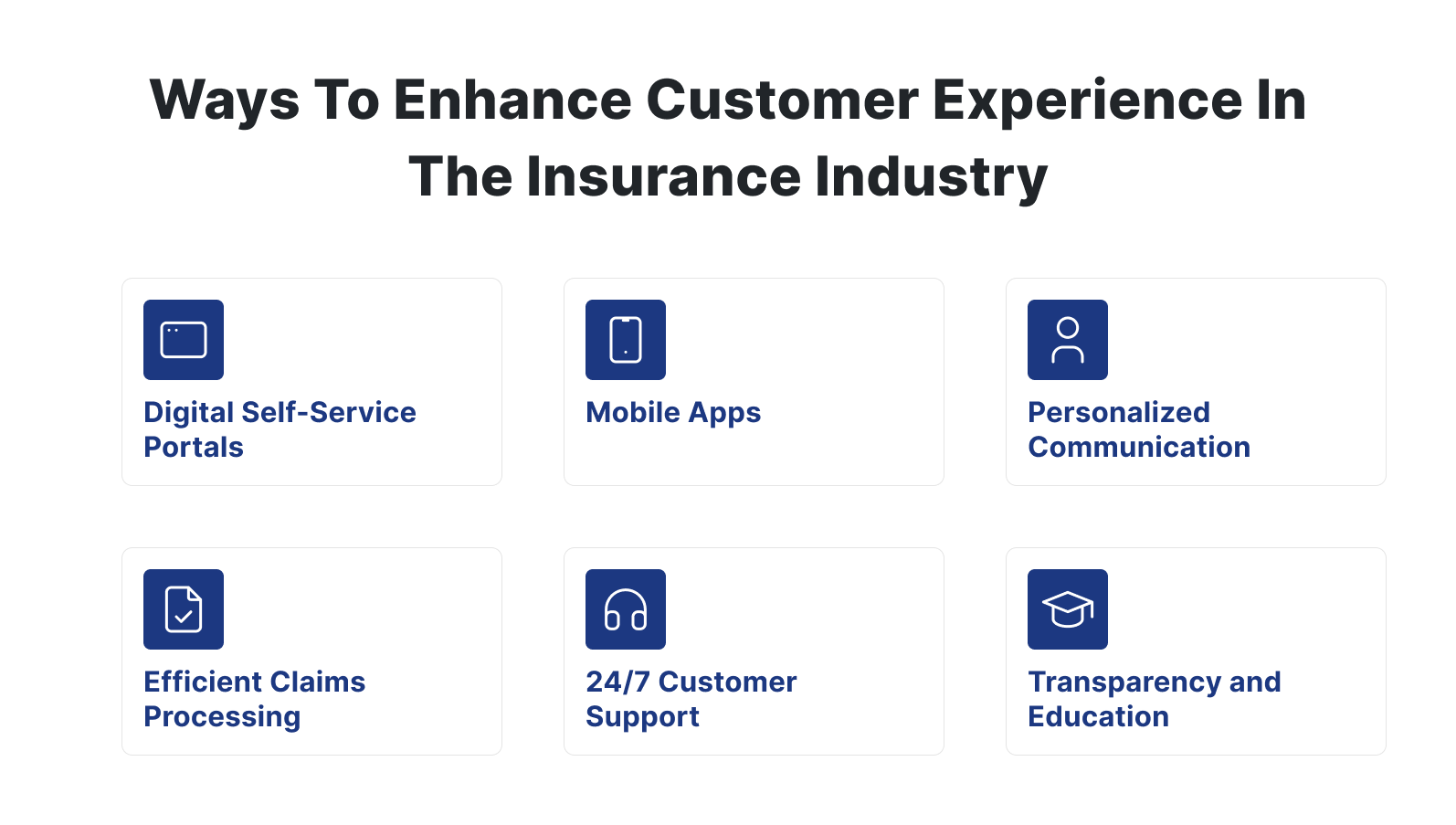The Digital Imperative: A Perspective Of CTOs In Transforming Life Insurance with Technology
Challenges that By CTOs in transforming life insurance with technology :- 1. Legacy System, 2. Data Management, 3. Customer Engagement, 4. Regulatory Compliance
Introduction
- In the ever-changing environment of the life insurance market, the digital necessity has become increasingly clear. CTOs are faced with negotiating a complicated set of difficulties while leveraging technology to alter established methods. The challenges are vast and complex, from legacy systems and data management to consumer interaction and regulatory compliance.

- In this blog, we will explore the problems and solutions for CTOs in transforming life insurance with technology. We look at the problems CTOs confront while embracing digital transformation and the inventive solutions required to overcome them. We explore technology's revolutionary potential in transforming the industry from the perspective of seven major areas: legacy systems, data management, customer interaction, regulatory compliance, cybersecurity concerns, operational efficiency, and market disruption
Challenges Faced by CTOs in Driving Innovation in Established Companies

1.Legacy System
-
Legacy systems are old technological platforms or software programs still used within an organization. In the life insurance industry, legacy systems include mainframe computers, outdated database systems, or custom-built software incompatible with newer technology. These systems frequently lack the flexibility, scalability, and integration capabilities to meet the sector's changing demands.
-
Migrating away from old systems may be difficult and expensive, necessitating meticulous planning, risk assessment, and implementation methodologies to guarantee minimal interruption to business operationsThis can be a challenge for the CTOs in transforming life insurance with technology.
2.Data Management
-
Data management refers to the methods and technology used to efficiently gather, store, organize, and analyze data. Data management is critical in the life insurance sector because of the massive amount of information created by policyholders, claims, underwriting, and financial activities. Effective data management techniques include assuring data quality, integrity, and security and providing timely access and analysis to support informed decision-making.
-
Data management challenges may consist of data silos, inconsistent data formats, and compliance with data protection requirements such as GDPR or CCPA. If the CTOs transform life insurance with technology, they will face several challenges, such as data management. This can be a challenge for the CTOs in transforming life insurance with technology.
3.Customer Engagement
-
Customer engagement refers to how life insurance firms connect with their customers throughout their lifetime. In today's digital era, customers want personalized, frictionless, and convenient experiences at all touchpoints, including policy purchases, service access, and claims management. However, traditional life insurance models rely on manual procedures and outmoded communication channels, resulting in low client satisfaction and retention.
-
If the company has customers who are likely to buy insurance in the traditional way, then the company can not engage this type of customer with the current technology. If the customer lacks knowledge about modern technology, then CTOs also face challenges.
4.Regulatory Compliance
-
Given the high level of regulation in the life insurance market, regulatory compliance is crucial. Insurers must follow a complicated network of local, national, and international rules that regulate all business areas, including product creation, sales tactics, underwriting, and claims processing. This can be a challenge for the CTOs in transforming life insurance with technology.
-
Failure to comply with regulatory regulations can lead to significant penalties, legal ramifications, and reputational harm. CTOs must follow specific laws to transform the insurance business digitally and face challenges in adopting the laws in the company.
-
For example, if a company adopts electronic transactions in its business, it will need to follow the Electronic Transactions and Signatures Laws, which are defined as Laws like the Electronic Signatures in Global and National Commerce Act in the US and the eIDAS Regulation in the European Union that provide legal recognition for electronic signatures and transactions. Companies often adopt electronic signature solutions and other digital tools to streamline processes and facilitate online transactions.
5.Cybersecurity Risks
- Cybersecurity threats threaten the confidentiality, integrity, and availability of sensitive data in the life insurance market. With the rising digitalization of operations and the sophistication of cyber threats, insurers are subject to various cyber assaults, such as data breaches, ransomware attacks, and phishing scams. Cybersecurity breaches can have serious implications, including financial losses, regulatory fines, and reputational harm. This can be a challenge for the CTOs in transforming life insurance with technology.
6.Operational Efficiency
- Operational efficiency refers to a life insurance company's capacity to optimize its processes, resources, and workflows to maximize productivity and profit. Inefficient procedures, manual jobs, duplicate operations, and antiquated technology can all reduce operational efficiency, resulting in higher expenses, delays, and mistakes. This can be a challenge for the CTOs in transforming life insurance with technology.
7.Market Disruption
- Market disruption refers to major changes or adjustments in the competitive environment of the life insurance market caused by technology improvements, regulatory changes, and changing client expectations. The advent of Insurtech companies, digital-native rivals, and disruptive technologies like blockchain, AI, and IoT are altering old business models and posing challenges to incumbent firms. Collapse to respond to market upheavals can lead to a loss of market share, decreased revenue, and, eventually, business collapse. This can be a challenge for the CTOs in transforming life insurance with technology.
Solutions For CTOs In Transforming Life Insurance With Technology

1.Modernization of Legacy Systems
-
Legacy systems in the life insurance sector can reduce efficiency, scalability, and innovation. CTOs can solve this issue by modernizing outdated systems via digital transformation efforts. This includes transferring data and applications to cloud-based platforms, using contemporary software architectures such as microservices, and incorporating new technologies to enhance system efficiency and flexibility. This can be a solution for the CTOs to transform life insurance with technology.
-
An example of a successful modernization of the legacy system is Netflix. Netflix began as a DVD rental service 1997, mailing DVDs to subscribers through a subscription-based model. However, with the rise of digital streaming technology and changing consumer preferences, Netflix recognized the shift towards online streaming and made strategic moves to adapt to the evolving market landscape.
-
In 2007, Netflix launched its streaming service, allowing subscribers to stream a vast library of movies and TV shows directly to their devices over the internet. This move revolutionized how people consume entertainment, Providing on-demand access to a variety of content without needing physical media.
-
As streaming technology improved and internet connectivity became more widespread, Netflix invested heavily in original content production, creating critically acclaimed TV series, movies, and documentaries. This strategic shift towards original content allowed Netflix to differentiate itself from competitors and attract a growing subscriber base.
2.Advanced-Data Analytics
- Data analytics is critical for improving life insurance operations by giving insights into client behavior, risk assessment, and operational efficiency. CTOs can use sophisticated analytics techniques like predictive Using modelling, machine learning, and artificial intelligence to sort data massive volumes of data and derive valuable insights. This information may help guide product development, underwriting choices, and consumer segmentation strategies, resulting in more personalized and cost-effective insurance products. This can be a solution for the CTOs to transform life insurance with technology.
3.Enhanced Customer Experience
- Improving the customer experience is critical to recruiting and keeping customers in the competitive life insurance industry. CTOs can use digital self-service portals, mobile applications, and chatbots to simplify the insurance purchasing process, facilitate policy administration duties, and give personalized help to policyholders. By improving the client experience, life insurance firms may boost customer happiness, loyalty, and retention.
There are some ways that insurance companies can enhance the customer experience, which are listed below.

A.Digital Self-Service Portals
- Develop simple and user-friendly online interfaces for customers to manage their insurance policies, read policy documentation, make payments, and process claims. Self-service portals enable users to do everyday tasks easily and independently, increasing overall satisfaction. This can be a solution for the CTOs to transform life insurance with technology.
B.Mobile Apps
- Create mobile apps that provide convenient access to insurance services and information. Customers may benefit from mobile applications, including policy administration, claims reporting, roadside help, and real-time notifications, providing convenience and flexibility. This can be a solution for the CTOs to transform life insurance with technology.
C.Personalized Communication
- Use consumer data and analytics to personalize communications with policyholders. Send tailored communications, offers, and suggestions based on individual preferences, life events, and insurance requirements to provide a more personalized and engaging customer experience. This can be a solution for the CTOs to transform life insurance with technology.
D.Efficient Claims Processing
- Streamline the claims process to reduce consumer paperwork, delays, and friction. Implement digital claims filing and processing technologies, enable online claims monitoring, and send proactive updates to keep clients informed throughout the claims process. This can be a solution for the CTOs to transform life insurance with technology.
E.24/7 Customer Support
- Provide 24-hour customer service across several phone, email, chat, and social media channels. Ensure rapid response times, experienced agents, and sympathetic service to resolve customer queries, problems, and emergencies as soon as possible. This can be a solution for the CTOs to transform life insurance with technology.
F.Transparency and Education
- Give clients clear information about insurance products, coverage alternatives, terms, and conditions to help them make educated selections. Provide instructional tools, FAQs, and guides to help clients understand their insurance policy better. This can be a solution for the CTOs to transform life insurance with technology.
4.Regulatory Compliance Solutions
- Life insurance firms must adhere to various regulatory obligations, including data privacy laws, anti-money laundering rules, and insurance industry standards. CTOs may use technological solutions like compliance management software, data encryption technologies, and audit trails to maintain regulatory compliance in all facets of their businesses. By proactively addressing compliance obligations, life insurance firms may reduce legal risks and create confidence with regulators and consumers. This can be a solution for the CTOs to transform life insurance with technology.
5.Cybersecurity Measures
- Life insurance firms prioritize protecting sensitive client data and digital assets against cyber attacks. CTOs may protect their organizations from data breaches, malware assaults, and other cyber dangers by implementing cybersecurity measures such as firewalls, intrusion detection systems, encryption protocols, and staff training programmes. Prioritizing cybersecurity allows life insurance firms to protect their digital systems and services' confidentiality, integrity, and availability. This can be a solution for the CTOs to transform life insurance with technology.
6.Streamlined Operations
- Streamlining operations is critical for increasing efficiency, lowering costs, and speeding up time-to-market for life insurance products and services. CTOs may use technology solutions like RPA, workflow management systems, and digital document management platforms to automate manual jobs, optimize business processes, and reduce bottlenecks in the insurance value chain. Life insurance firms may optimise resource allocation, increase efficiency, and provide a consistent client experience by simplifying processes. This can be a solution for the CTOs to transform life insurance with technology.
7.Innovation and Agility
-
Life insurance businesses must innovate and adapt to remain competitive in a continually changing industry. CTOs may build a culture of innovation and agility by investing in emerging technology, promoting experimentation, and adopting agile development practices. In the digital age, life insurance businesses may foresee market trends, respond to consumer wants, and differentiate themselves from rivals by constantly inventing and iterating on goods, services, and procedures. This can be a solution for the CTOs to transform life insurance with technology.
-
Let's take an example of Zomato how they make an innovation in their product and. At present, Zomato is ruling the market.
-
Zomato, a trailblazer in the food delivery and restaurant discovery industry, has demonstrated a remarkable commitment to innovation and technological advancement. At the core of its success lies a relentless pursuit of excellence through product development, Powered by a thorough grasp of customer requirements and market dynamics.
-
By investing in research and development, Zomato continuously refines its platform, introducing innovative features and services that redefine the dining experience for millions of users worldwide. Whether it's real-time order tracking, personalized recommendations, or contactless dining solutions, Zomato's innovative products reflect its dedication to enhancing user convenience, safety, and efficiency.
-
Zomato harnesses the power of data analytics and artificial intelligence (AI) to unlock valuable insights and optimize its operations. By analyzing vast amounts of user data, Zomato gains a deeper understanding of consumer preferences, dining trends, and market opportunities.
-
This data-driven approach enables Zomato to personalize recommendations, tailor promotions, and optimize search results, enhancing user engagement and satisfaction. Moreover, Zomato's strategic partnerships with technology companies and startups provide access to cutting-edge solutions and expertise, enabling the company to integrate innovative technologies into its platform and stay at the forefront of industry trends.
Conclusion
-
As we conclude our investigation of the digital imperative in changing life insurance with technology, it is clear that the obstacles encountered by CTOs are substantial but surmountable. The environment is riddled with challenges that necessitate inventive solutions, from the restrictions of legacy systems to the complexities of regulatory compliance and the ever-present threat of cyber hazards.
-
However, within these problems comes enormous opportunity. CTOs may pave the path for a new age of digital excellence in life insurance by forming strategic collaborations with technology professionals such as Insurnest Technolabs and committing to continuous innovation. Insurers may open up new opportunities for development, differentiation, and long-term success by modernizing processes, using data, and prioritizing client interaction.
Contact Us
Frequently Asked Questions
How are CTOs transforming life insurance through technology?
CTOs are transforming life insurance by implementing AI-driven underwriting, digital customer experiences, automated claims processing, data analytics platforms, and innovative product development using emerging technologies.
What digital transformation strategies do life insurance CTOs employ?
CTOs employ strategies including cloud migration, API-first architectures, microservices implementation, data lake creation, AI/ML integration, and customer-centric digital platform development.
How do CTOs address legacy system challenges in life insurance?
CTOs address legacy challenges through gradual modernization, API wrapper implementations, cloud-native solutions, data migration strategies, and hybrid architectures that bridge old and new systems.
What emerging technologies are life insurance CTOs prioritizing?
CTOs prioritize artificial intelligence, blockchain for smart contracts, IoT for risk assessment, cloud computing for scalability, and advanced analytics for personalized customer experiences and risk management.

